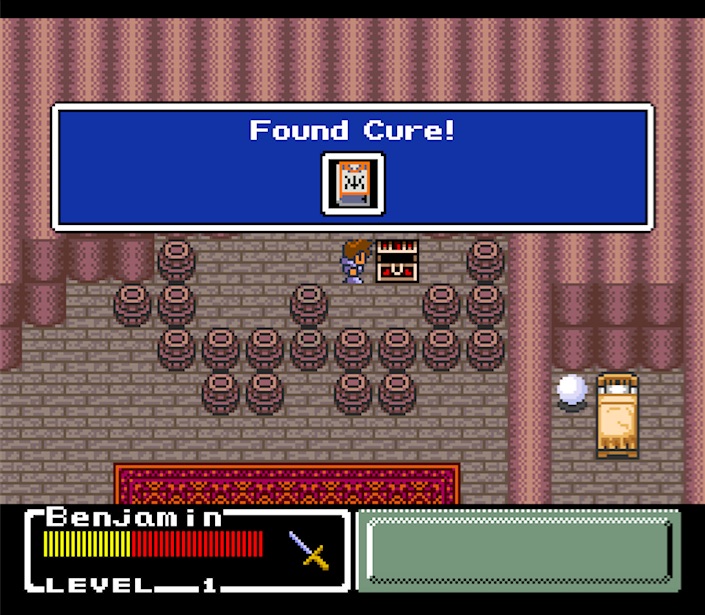In the fall of ’92, when the Berlin Wall was confetti and Courtney Love hadn’t choked the life out of Kurt Cobain, Final Fantasy: Mystic Quest lumbered onto the scene like a hungover Sasquatch at a soccer mom picnic. Designed as a “dumbed-down” RPG by marketing executives who thought American gamers were drooling troglodytes, it hit shelves and faced immediate fan rejection.
For decades, Mystic Quest has been long regarded as “the worst Final Fantasy“. Was it really, though? Most of the time the disdain this game gets is due to fans assuming that it was meant to replace Final Fantasy V. Has all the hate from all these years been warranted? Was it secretly a good game all along? Does it deserve all the hate it gets? Find out in this Final Fantasy: Mystic Quest review!
Final Fantasy: Mystic Quest
Developer: Squaresoft
Publisher: Square Enix, Squaresoft
Platforms: Super Nintendo Entertainment System, Nintendo Wii Virtual console
Release Date: October 5, 1992 / September 24, 2010
Price: n/a

The early to mid-90s saw a flourishing of great RPGs, with masterpieces like Soul Blazer and Shining Force. It was also a time when Squaresoft, well-known for holding back some of its best titles like Trials of Mana and Romancing Saga entries, felt Western audiences needed a gentle introduction to the genre.
Localizing RPGs was challenging in the 90s due to extensive text, making them a niche market. This is where Mystic Quest came in, aiming to ease Western players into the genre without overwhelming them.
Designed to be an accessible entry point for newcomers to the RPG genre, Final Fantasy Mystic Quest is aimed at a young audience with its straightforward story and simplistic mechanics. While the narrative lacks depth, its focus on clear objectives and minimal ambiguity ensures younger players can easily follow along.

Its lack of character development, including the protagonist’s blank-slate personality, will leave older gamers yearning for more emotional investment. audience. Benjamin rarely expresses much outside of an incredulous shrug, as if he’s being dragged along against his will.
The turn-based system allows for simple party management, with Benjamin always paired with a story-driven companion. Further emphasizing accessibility, stats are displayed as clear life bars instead of numbers, minimizing the need for calculations.
All enemies are visible and stationary on the world map, never respawning. While this eliminates grinding entirely and it also leaves the world feeling empty after all encounters are cleared.

The finite battle arenas offer the closest opportunity for additional battles, but these don’t quite fill the void of traditional side quests. The lack of grinding might be refreshing for some, but it’s important to note that Mystic Quest‘s simple story may leave players wanting more engaging activities in its later stages.
Final Fantasy Mystic Quest‘s exploration shares similarities with Zelda games, offering action-oriented elements like chopping trees, bombing walls, and using a hook shot. These cool tools are acquired through the linear story and also add variety to turn-based combat. While dungeons require some logic to navigate, the overall experience is pretty easy and caters to younger players or those new to RPGs.
Mystic Quest‘s pixel art, while quaint, straddles the line between NES and SNES styles. A neat visual flourish is large boss sprites that transform to visually depict their weakening state, a surprisingly absent feature in other 2D RPGs.

While the overall visuals remain simplistic for its time, the music truly shines. Composed by Ryuji Sasai and Yasuhiro Kawakami, the soundtrack elevates the experience far beyond its gameplay, particularly with its fast-paced, metal-inspired battle themes.
Nobuo Uematsu usually overshadows Ryuji Sasai and Yasuhiro Kawakami and it’s a shame because their work deserves more attention. Battle and boss themes, fueled by gritty electric guitar samples and a fast tempo, inject much-needed urgency into the pedestrian strategy. The boss theme was so metal and intense that it made its way onto Theatrhythm Final Fantasy as DLC.
Unjustly judged upon its release, Mystic Quest aimed to be an accessible entry point for newcomers to the RPG genre. Despite sacrificing depth for digestibility, the team crafted a polished product. Squaresoft could have avoided comparisons by marketing it as a standalone adventure, which might have hindered its visibility. Square probably made the right call in the face of the negative reception.

Mystic Quest holds fond memories for some, and with good reason. This quaint RPG, perfect for young gamers starting to read and do math, offers a clear story and simple mechanics. For a kid playing it for the first time, it was mindblowing to explore such a large world full of characters.
These days, you’re not going to find Final Fantasy: Mystic Quest anywhere. It isn’t on Nintendo Switch Online. The eShop version on the Virtual Console has long been shut down so if you didn’t already own it, you’re shit out of luck. You can’t buy it anymore. Apart from emulation, the only option is to find a cart for the original hardware because Square Enix isn’t about to rerelease it any time soon.
While experienced RPG players might find it lacking, it perfectly fulfills its purpose: introducing younger audiences to the genre. As a child, my first adventure in Mystic Quest sparked a lifelong love for RPGs. If it wasn’t for this game, I probably wouldn’t have gotten into writing about them.
Final Fantasy: Mystic Quest was reviewed on Super Nintendo Entertainment System using a copy purchased by Nichegamer. You can find additional information about Niche Gamer’s review/ethics policy here. Final Fantasy: Mystic Quest is now available for Super Nintendo Entertainment System.
